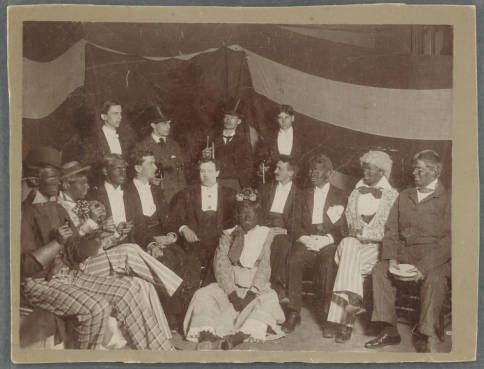At the height of the American Civil War, the debate on slavery raged in the American North and South. The North supported the abolition of slavery whereas the South wanted to keep the institution of slavery to sustain their plantation-centric economy. Where Shakespeare’s The Tempest enters the fray is with a political cartoon published at the midpoint of the war: January 24, 1863.
Following Abraham Lincoln’s Emancipation Proclamation on January 1, 1863, which declared that all slaves in rebellion states were declared free, the British political satire publication Punch, or The London Charivari printed a cartoon on January 24, 1863 depicting a slave interacting with Abraham Lincoln and Jefferson Davis in the words of Caliban, Prospero’s enslaved servant.
In the engraving titled ‘Scene from The American Tempest,’ Punch depicts a slave receiving a copy of the Emancipation Proclamation from Abraham Lincoln, and swearing to help defeat the Confederacy, as represented by the Confederacy President Jefferson Davis. Although the Proclamation declared that ‘all persons held as slaves within the Confederate States are and henceforth shall be free,’ it set aside certain conditions for the former enslaved African and African Americans to meet. Firstly, it emphasized the need for emancipated slaves to abstain from violence and to labor faithfully for wages. Secondly, it declared that all slaves of ‘suitable condition’ would be received into the armed services of the United States Union army. As the cartoon points out, the Emancipation Proclamation was not making a statement to oppose the practice of slavery, but a statement made as a measure for war. The emancipated slaves continued to grease the racist and labor-centric machine that was the American war machine.
Delving deeper into the imagery and language of the cartoon, the depiction of the slave as Caliban is highly problematic. Standing knock-kneed with a dumbfounded smile upon his exaggerated face and cranium, Caliban the slave doubles the description of Caliban in the language of The Tempest:
“A freckled whelp hag-born – not honored with a human shape” (1.2.419-20)
“Demi-devil…bastard” (5.1.2346-7)
“Strange fish…monster” (2.2.1112-15)
“Abhorred slave…savage” (1.2.504-8)
The last of the lines, spoken from Miranda’s mouth, reveal the real image of how the people of Shakespeare’s time viewed African and Indigenous people.
Throughout the course of the play, Caliban is viewed as a savage being, but gentle and dumb and stupid. More than 300 years after The Tempest was published and 100 years after the Punch cartoon was printed, Octave Mononni, in his famous psychoanalytic study of the colonized and the colonizer Prospero and Caliban: The Psychology of Colonization, asserts this same primitive viewpoint of Caliban in the 1950s. The contented slave, who then rebels upon his master, like Caliban, does so because the slave is fixed in a childlike state. He is incapable of initiative, loses his head, and appears quite unintelligent. The image of the disfigured, physically and mentally retarded native is perpetuated for hundreds of years and his language is often lampooned as well.
At the bottom of the cartoon is the caption:
Caliban (Sambo) points to the Confederate soldier and says: You Beat Him ‘Nough, Massa! Berry Little Time, I’ll Beat Him Too. – ‘Shakespeare. (Nigger Translation.)’
This is a direct adaptation from a line in The Tempest by Caliban where he states “Beat him enough: after a little time I’ll beat him too” (3.2.1479-80). As a newly liberated ‘Sambo,’ the slave figure of Caliban and the real slaves from the War are depicted according to white stereotypes. The fake Slave/African minstrel accent, expression of “massa,” and the bastardized language – the “Nigger Translation” of British High Culture Shakespeare – is blatantly racist and was, like the racist image of the black man, used in popular literature and popular songs/music throughout the 20th century (see: Thomas Dartmouth Rice’s Jim Crow).
In fact, the featured image for the post is a photograph of Delta Kappa Epsilon students performing a minstrel show in blackface as the Sambo character at Dartmouth College in 1895, no more than 30 years after this cartoon was published in the Punch.
This cartoon from the 19th century reflects the images and stereotypes associated with enslaved black men and women and the continued racism stemming from the white view of the African people. The postcolonial rhetoric that emerged in the late 20th century arose out of the need for black scholars to interpret these popular works and look at how fundamentally and structurally racist society was and continued to be throughout colonial history. The black Sambo is still a problem faced everyday and Shakespeare’s Tempest is a vehicle for the development of postcolonial representations of Caliban. The Punch cartoon connects Britain and the New World, Shakespeare with American slavery, and reveals the racism that continues to play a role in the study and depiction of members of the black community.
Works Cited
http://www.opensourceshakespeare.org/views/plays/play_view.php?WorkID=tempest&Scope=entire&pleasewait=1&msg=pl
http://www.aaregistry.org/historic_events/view/thomas-rice-face-jim-crow
http://sdonline.org/33/the-sambo-thesis-revisited-slaverys-impact-upon-the-african-american-personality/
http://wmich.edu/dialogues/texts/atempest.html


